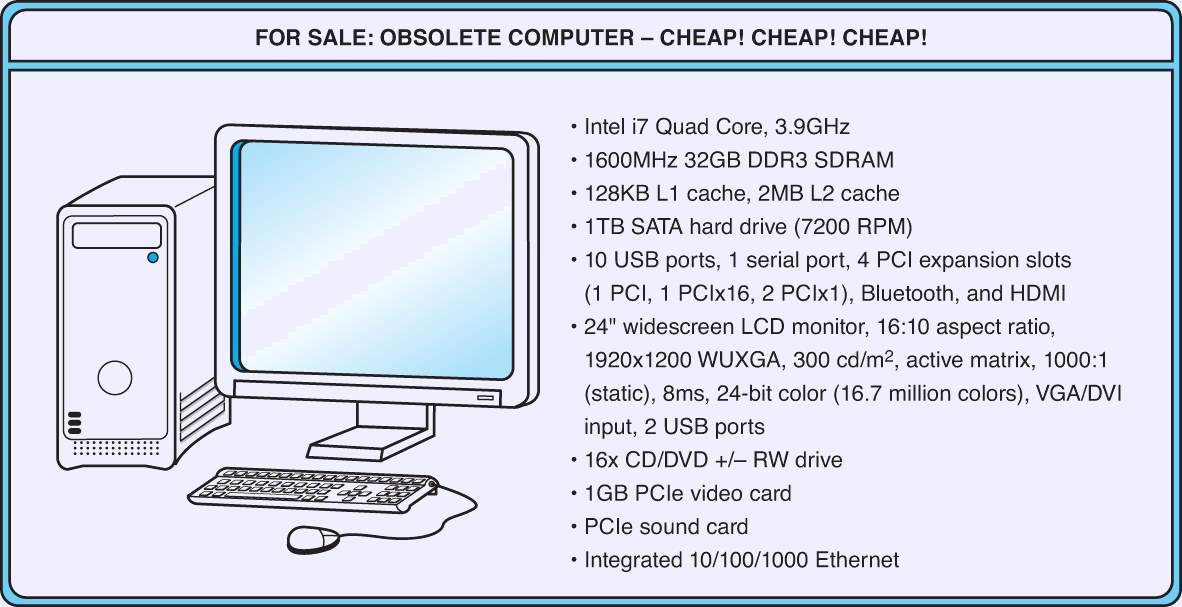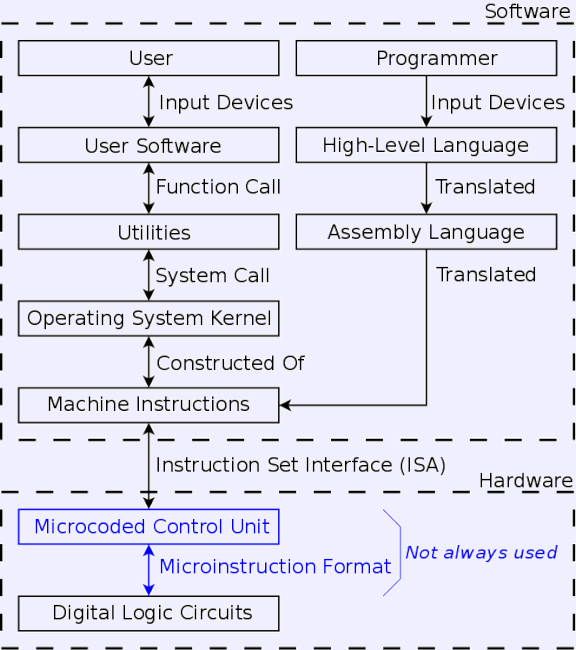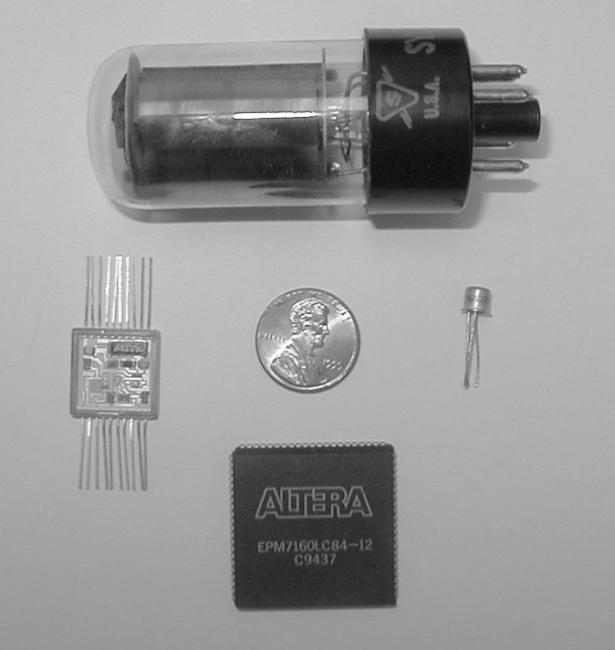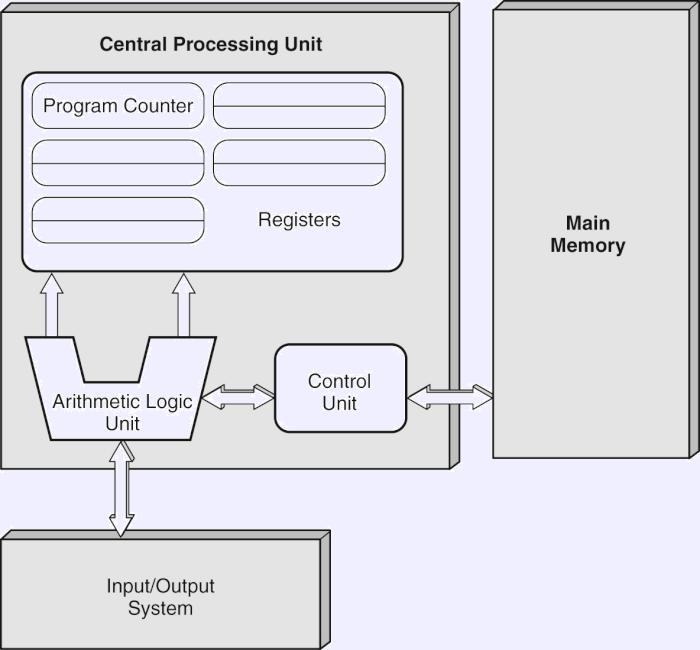- Organization and architecture.
- Computer organization: how parts are combined to make a working
whole.
- Physical aspects of the computer.
- Types memory and other components.
- Signals and control protocols.
- Computer architecture: how the organization is presented to the
programmer.
- Instruction sets and codes
- How memory is addressed
- How I/O is accomplished
- Instruction Set Architecture (ISA): The interface between
software and hardware.
- Hardware and software
- Any program is executed by some interpreter.
- That interpreter may be software or hardware.
- Of course, you have to reach hardware eventually to have something
you can run.
- Could you build a JVM in hardware?
- Any task done by software could be done by hardware instead.
- Any task done by hardware could be done by software instead.
- Though the software still needs an interpreter, so you can apply the
rule recursively.
- Since recursion needs a base case, you'll have some hardware
eventually.
- Hardware solutions usually run faster.
- A computer has
- Processor(s) to interpret and execute instructions
- Memory to store both data and programs.
- Mechanism to transfer data to and from the outside.
- Computer Guts.
- Sizes.
- Memory is always in binary: 1K = 1024, 1M = 10242, etc.
- Disks sizes
- Often in binary
- Formatting consumes a good bit of the hardware space.
- Processors.
- Typically multi-core these days: multiple CPUs on one chip.
- Clock speed in the GHz range.
- The clock is a circuit which generates a pulse at a regular rate.
- Makes the CPU do the next thing, whatever that is.
- Chapter 3.
- Chapters 4 and 5.
- Main Memory. Typically SDRAM.
- Synchronous Dynamic Random Access Memory.
- Chapter 6.
- System bus. Connects between CPU, Memory and some other parts.
Chapter 4.
- Cache memory.
- Holds a copy of a portion of the main memory.
- Operates must faster.
- Speeds up a large percentage of memory operations, since they can be
satisfied from cache.
- Chapter 6.
- Storage
- I/O bus speed.
- Moves data to and from I/O devices.
- Separate from the system bus.
- Hard drive: rotational speed matters.
- Solid state (flash) storage: Very different properties from a
hard drive.
- Optical
- Chapter 7.
- (Other) peripheral devices.
- Display
- Graphics processor. (Yes, it's an extra processor.)
- Network Interface Card (NIC). (Which usually isn't a separate
card anymore.)
- Standards Organizations. Standards allow various components to work
together, even when made by different manufacturers.
- Institute of Electrical and Electronics Engineers (IEEE). Buses,
low-level networking, many others.
- International Telecommunications Union (ITU).
- International Standards Organization (ISO).
- Coordinates national standards bodies.
- US is the American National Standards Institute (ANSI).
- Organizations specialized around specific standards.
- InterNational Committee for Information Technology Standards (INCITS).
Disk I/O bus standards, and some others.
- The USB Implementers Forum.
- Generations.
- Gen. 0. Mechanical computation.
- Abacus. Really a memory system.
- Pascal's calculator. Invented 1642.
Basic design still used in the 1950s.
- Babbage
- Difference engine. 1882. A calculator.
- Analytical engine. A computer.
- Punched cards.
- Early use: Jacquard Loom. Controlled patterns sewn into the cloth.
- Babbage used them to control his equipment.
- Hollerith cards.
- Created for 1890 census.
- Standard for computing into the (gak!) 1980's.
- Electro-mechanical: relays.
- Conrad Zuse, Germany, during WWII.
- Harvard Mark I (started 1939).
- Gen. 1. Vacuum tubes.
- Tubes must be heated. Use lots of power, leave lots of heat.
- Routinely burn out and must be replaced.
- Conrad Zuse again. Design only, though. Couldn't get the tubes.
- Atanasoff-Berry (ABC).
- Mauchly and Eckert, ENIAC.
- More than a lab toy.
- 17,468 vacuum tubes.
- Funded by the army to calculate ballistic tables.
- Gen. 2. Transistors.
- Bell Labs: Bardeen, Brattain, Schockley.
- Solid state (v. ionized) version of the vacuum tube, but
- Uses much less power.
- Generates much less heat.
- Doesn't burn out.
- Start of a large commercial computing industry.
- Gen. 3. Integrated circuits.
- Transistor circuits (including many transistors) built at once in a
single device.
- Dozens at first.
- Constantly increasing.
- Allowed small computers to be cheaper, expanding use beyond government
and the largest companies and universities.
- Allowed the largest computers to be larger. Rise of
“supercomputers.”
- The electric valve.
- Essentially a switch controlled by current on another circuit.
- Relays, vacuum tubes, and transistors are all
such controlled switches.
- Gen. 4. Very-large-scale integrated circuits.
- Chips in excess of 10,000 components.
- Or millions. Or billions.
- Particularly, a complete CPU.
- Allows the creation of the PC, and later portable computing.
- Moore's Law.
- The density of silicon chips doubles every 18 months.
- Not some law of nature; will hold as long as engineers keep
figuring out how make it hold.
- Originally a prediction for 10 years out. Has held for 40.
- Layered Design.
- Think the figure in the book mixes some different things.
- Machine instructions are bit patterns stored in the computer's
memory.
- The Instruction Set Interface (ISA) describes the format and
meaning of the instructions.
- The ISA is the interface between software and hardware.
- Assembly language is a symbolic form of machine instructions.
- Von Neumann Architecture
- Stored program: Program stored in memory along with the data.
- Sequential processing of instructions.
- Single path between CPU and memory: The Von Neumann Bottleneck.
- Fetch-execute cycle.
- CPU fetches the instruction denoted by the PC.
- CPU decodes the fetched instruction.
- Any needed operands are fetched.
- The operation is performed, and any results are stored.
- Some parallel systems discard Von Neumann; common ones just have several.
- Clustering.
- Multicomputers.
- Multi-core computers.
- What's not Von Neumann?
- Things like multiple buses, or a small number of
multiple memories, that aren't very different.
- Send the operation to the data, not the other way 'round.
- Instructions applied in parallel to a set of data.
- Adding computing power to memory, including hardware neural networks.



